Doune Castle: Difference between revisions
Created page with "{{Infobox castle |name=Doune Castle |village=Doune |county=Perthshire |picture=Doune Castle - front.jpg |picture caption=Doune Castle |os grid ref= NN727010 |latitude=56.18515..." |
No edit summary |
||
| (One intermediate revision by the same user not shown) | |||
| Line 15: | Line 15: | ||
|condition=Ruined | |condition=Ruined | ||
|ownership=Historic Scotland | |ownership=Historic Scotland | ||
|website={{HES link}} | |||
}} | }} | ||
'''Doune Castle''' is a mediæval stronghold near the village of [[Doune]], in [[Perthshire]]. The castle is sited on a wooded bend where the Ardoch Burn flows into the [[River Teith]], eight miles upstream of [[Stirling]], where the Teith enters the [[River Forth]]. Eight miles upsteam of Doune is [[Callander]], at the edge of the [[Trossachs]], on the fringe of the [[Highlands]]. | '''Doune Castle''' is a mediæval stronghold near the village of [[Doune]], in [[Perthshire]]. The castle is sited on a wooded bend where the Ardoch Burn flows into the [[River Teith]], eight miles upstream of [[Stirling]], where the Teith enters the [[River Forth]]. Eight miles upsteam of Doune is [[Callander]], at the edge of the [[Trossachs]], on the fringe of the [[Highlands]]. | ||
| Line 116: | Line 117: | ||
==Outside links== | ==Outside links== | ||
{{Commons}} | {{Commons}} | ||
*{{ | *{{HES link}} - Historic Environment Scotland | ||
*[http://www.doune.co/index.php/heritage/doune-castle Doune Community], Information and Heritage centre | *[http://www.doune.co/index.php/heritage/doune-castle Doune Community], Information and Heritage centre | ||
Latest revision as of 19:20, 15 May 2016
| Doune Castle | |
|
Perthshire | |
|---|---|
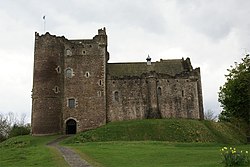 Doune Castle | |
| Type: | Tower house and courtyard |
| Location | |
| Grid reference: | NN727010 |
| Location: | 56°11’7"N, 4°3’1"W |
| Village: | Doune |
| History | |
| Built c.1400 | |
| Information | |
| Condition: | Ruined |
| Owned by: | Historic Scotland |
| Website: | Doune Castle |
Doune Castle is a mediæval stronghold near the village of Doune, in Perthshire. The castle is sited on a wooded bend where the Ardoch Burn flows into the River Teith, eight miles upstream of Stirling, where the Teith enters the River Forth. Eight miles upsteam of Doune is Callander, at the edge of the Trossachs, on the fringe of the Highlands.
Recent research has shown that Doune Castle was originally built in the thirteenth century, then probably damaged in Edward I's wars,[1] before being rebuilt in its present form in the late 14th century by Robert Stewart, Duke of Albany (c.1340–1420), the son of King Robert II of Scotland, and Regent of Scotland from 1388 until his death. Duke Robert's stronghold has survived relatively unchanged and complete, and the whole castle was traditionally thought of as the result of a single period of construction at this time.[2] The castle passed to the crown in 1425, when Albany's son was executed, and was used as a royal hunting lodge and dower house. In the later 16th century, Doune became the property of the Earls of Moray.
The castle saw military action during the Wars of the Three Kingdoms and in Glencairn's rising in the mid-17th century, which arose from those wars. It saw action too during the Jacobite Risings of the late 17th century and 18th century.
By 1800 the castle was ruined, but restoration works were carried out in the 1880s, before it passed into state care in the 20th century. It is now maintained by Historic Scotland.
Due to the status of its builder, Doune reflected current ideas of what a royal castle building should be.[3] It was planned as a courtyard with ranges of buildings on each side, although only the northern and north-western buildings were completed.[4] These comprise a large tower house over the entrance, containing the rooms of the Lord and his family, and a separate tower containing the kitchen and guest rooms. The two are linked by the great hall. The stonework is almost all from the late 14th century, with only minor repairs carried out in the 1580s. The restoration of the 1880s replaced the timber roofs and internal floors, as well as interior fittings.
History
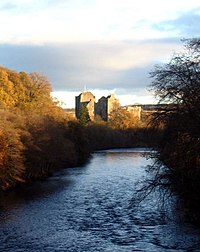
The site at the confluence of the Ardoch Burn and the River Teith had been fortified by the Romans in the 1st century AD, although no remains are visible above ground.[3] Ramparts and ditches to the south of the present castle may be the site of an earlier fortification, as the name Doune is believed to be derived from Gaelic dùn, meaning "fort".[5] The earliest identifiable work in the castle dates from the thirteenth century,[1] but it assumed its present form during one of the most creative and productive periods of Scottish mediæval architecture, between 1375 and 1425, when numerous castles were being built and remodelled, including Dirleton and Tantallon in Lothian, and Bothwell in Lanarkshire.[6]
Regent Albany
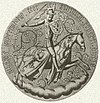
In 1361, Robert Stewart, son of King Robert II (1371–1390), and brother of King Robert III (1390–1406), was created Earl of Menteith, and was granted the lands on which Doune Castle now stands. Building may have started any time after this, and the castle was at least partially complete in 1381, when a charter was sealed here.[3] Robert was appointed Regent in 1388 for his elderly father, and continued to hold effective power during the reign of his infirm brother. He was created Duke of Albany in 1398. In 1406, Robert III's successor, James I, was captured by the English, and Albany became Regent once more. After this time, the number of charters issued at Doune suggest that the castle became a favoured residence.[3]

Royal retreat
Albany died in 1420, and Doune, the dukedom of Albany, and the Regency all passed to his son Murdoch (1362–1425). The ransom for James I was finally paid to the English, and the King returned in 1424, taking immediate steps to gain control of his kingdom. Albany and two of his sons were imprisoned for treason, and then executed in May 1425. Doune Castle became a royal possession, under an appointed Captain, or Keeper, and served as a retreat and hunting lodge for the kings. It was also used as a dower house by Mary of Guelders (c.1434–1463), Margaret of Denmark (1456–1486), and Margaret Tudor (1489–1541), the widowed Queens of James II, James III and James IV respectively.[2]
In 1528, Margaret Tudor, now Regent of Scotland for her infant son James V, married Henry Stewart, 1st Lord Methven, a descendant of Albany. His brother, Sir James Stewart (c.1513–1554), was made Captain of Doune Castle, and Sir James' son, also James (c.1529–1590), was created Lord Doune in 1570.[2] Lord Doune's son, another James (c.1565–1592), married Elizabeth Stuart, 2nd Countess of Moray around 1580, becoming Earl of Moray himself. The castle thus came to be the seat of its keepers, the Earls of Moray, who owned it until the 20th century.[2]
Mary, Queen of Scots stayed at Doune on several occasions, occupying the suite of rooms above the kitchen.[7] Doune was held by forces loyal to Mary during the brief civil war which followed her forced abdication in 1567, but the garrison surrendered to the Regent, Matthew Stewart, 4th Earl of Lennox, in 1570, after a three-day blockade.[2] George Buchanan and Duncan Nairn, Deputy Sherriff of Stirling presided over the torture and interrogation of a messenger, John Moon, at Doune on 4 October 1570. Moon was carrying letters to Queen Mary and to Mary Seton.[8]
King James VI visited Doune on occasion, and in 1581 authorised £300 to be spent on repairs and improvements,[2] the works being carried out by the master mason Michael Ewing[5] under the supervision of Robert Drummond of Carnock, Master of Work to the Crown of Scotland.[9] In 1593, a plot against James was discovered, and the King surprised the conspirators, who included the Earls of Montrose and Gowrie, at Doune Castle.[2]
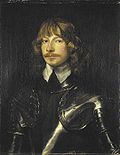
Prison and garrison
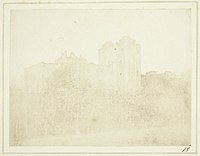
In 1607, the minister, John Munro of Tain, a dissenter against the religious plans of James VI, was imprisoned with a fellow minister at Doune, though he escaped with the contrivance of the then Constable of the Castle, who was subsequently imprisoned for aiding the dissenters. The Royalist James Graham, 1st Marquess of Montrose occupied Doune Castle in 1645, during the Wars of the Three Kingdoms. In 1654, during Glencairn's royalisty rising against the occupation of Scotland by Oliver Cromwell, a skirmish took place at Doune between Royalists under Sir Mungo Murray, and Cromwellian troops under Major Tobias Bridge.[2]
The castle was garrisoned by government troops during the Jacobite Rising of 'Bonnie Dundee']] in 1689, and repairs were ordered in response. It was garrisoned again during the rising of 1715]].[7] During the final Jacobite Rising, 1745, Doune Castle was actually occupied by Charles Edward Stuart, "Bonnie Prince Charlie", and his Jacobite Highlanders. It was used as a prison for government troops captured at the Battle of Falkirk the next year. Several prisoners, held in the rooms above the kitchen, escaped by knotting together bedsheets and climbing from the window.[2] Escapees included the author John Home, and a minister, John Witherspoon, who later moved to the American colonies and became a signatory of the United States Declaration of Independence.[10]
Ruin and restoration
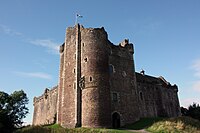
The castle deteriorated through the 18th century, and by 1800 Doune was a roofless ruin. It remained so until the 1880s, when George Stuart, 14th Earl of Moray (1816–1895) began repair works.[2] The timber roofs were replaced, and the interiors, including the panelling in the Lord's Hall, were installed.[5]
The castle was fdonated to the Ministry of Works by Douglas Stuart, 20th Earl of Moray, in 1984, and today it is in the care of Historic Scotland, and opened to the public. The castle is a Scheduled Ancient Monument, and a Category A listed building, the highest levels of protection for nationally important built heritage in Scotland.[11][12]
Description
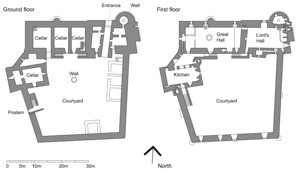
Doune occupies a strategic site only five miles from Stirling Castle, the "crossroads of Scotland".[5] The site is naturally defended on three sides by steeply-sloping ground, and by the two rivers to east and west. The castle forms an irregular pentagon in plan, with buildings along the north and north-west sides enclosing a courtyard. It is entered from the north via a passage beneath a tower containing the principal rooms of the castle. From the courtyard, three sets of stone external stairs, which may be later additions,[13] lead up to the Lord's Hall in the tower, to the adjacent Great Hall, and to the kitchens in a second tower to the west.
The main approach, from the north, is defended by earthworks, comprising three ditches, with a rampart, or earthen wall, between. Also outside the castle walls is a vaulted passage, traditionally said to lead into the castle, but in fact accessing an 18th-century ice house.[13] There are no openings within the lower part of the castle's walls, excepting the entrance and the postern, or side gate, to the west, although there are relatively large windows on the upper storeys. Windows in the south wall suggest that further buildings were intended within the courtyard, but were never built. The stonework is of coursed sandstone rubble, with dressings in lighter Ballengeich stone.[5]
The Lord's Tower
The principal tower, or gatehouse, is rectangular in plan 59 feet by 43 feet, and almost 95 feet high,[2] with a projecting round tower on the north-east corner, beside the entrance. It comprises the Lord's Hall, and three storeys of chambers above, located over the entrance passage.
The vaulted, cobbled passage, 46 feet long, was formerly defended by two sets of timber doors, and a yett, or hinged iron grille, remains.[5] Guardrooms on either side overlook the passage through gunloops, and also on the ground floor is a well, in the basement of the round tower.

There is no direct communication between the ground floor and the Lord's Hall above, which occupies the whole first floor. This is accessed via an enclosed and gated stair from the courtyard. The hall is vaulted, and has an unusual double fireplace. The floor tiles, timber panelling, and minstrels' gallery are additions of the 1880s. It was originally thought that the connecting door to the Great Hall was also of this date, but is now accepted as being original.[5] Side rooms on the hall level include a chamber in the round tower, with a hatch above the well, and a small chamber within the south wall which overlooks both hall and courtyard. A machicolation, or "murder hole", below the hall's north window, allows objects to be dropped onto attackers in the passage.[5]
Above the hall is a second hall, forming part of the Duchess' suite of rooms. An oratory in the south wall, overlooking the courtyard, contains a piscina and credence niche. The oratory gives access to mural passages leading to the walkway along the curtain wall. The timber ceiling of the Duchess' hall, and the timber floors and roof above, are of the 1880s. The upper parts of the stonework are among the repairs dating from 1580.[5]
Great Hall and kitchen tower
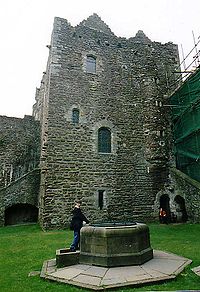
West of the Lord's tower is the Great Hall, 66 feet by 26 feet, and 39 feet high to its timber roof,[2] again a 19th-century replacement.[5] The hall has no fireplace, and was presumably heated by a central fire, and ventilated by means of a louvre like the one in the modern roof. No details of the original roof construction are known, however, and the restoration is conjectural.[3] Large windows light the hall, and stairs lead down to the three cellars on ground level.
The hall is accessed from the courtyard by a stair up to a triangular lobby, which in turn links the hall and kitchens by means of two large serving hatches with elliptical arches, unusual for this period.[14] The kitchen tower, virtually a tower house in its own right, is 56 feet by 26 feet. The vaulted kitchen is on the hall level, above a cellar. One of the best-appointed castle kitchens in Scotland of its date,[3] it has an oven and a 18.0-foot (5.5-m) wide fireplace. A stair turret, added in 1581 and possibly replacing a timber stair,[5] leads up from the lobby to two storeys of guest rooms. These include the "Royal Apartments", a suite of two bedrooms plus an audience chamber, suitable for royal visitors.[2]
Courtyard and curtain wall
Projecting stones on the south wall of the kitchen block, known as tuskings, and four pointed-arched windows in the south curtain wall, suggest that further ranges of buildings were planned. The large, eastern-most window, may have been intended for a chapel, and it is recorded that a chapel dedicated to the 8th-century monk Saint Fillan was located at Doune Castle, but the lack of foundations suggest that there was no large building in this part of the castle.[5] The foundations which do exist were excavated in September 2002, revealing a structure which was interpreted as a kiln or oven against the south wall.[13] The central well is around 59 feet} deep.[2]
The curtain wall is six feet thick, and 39 feet high.[2] A walkway along the top of the wall is protected by parapets on both sides, and is carried over the pitched roofs of the hall and gatehouse by steep steps. Open, round turrets are located at each corner, with semicircular projections at the midpoint of each wall. A square turret with machicolations is located above the postern gate in the west wall.[5]
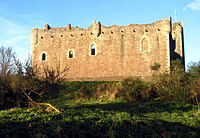
Interpretation of the layout
The Lord's tower is a secure, private set of rooms, probably intended for the sole use of the Lord and his family, and with its own lines of defence. The architectural historian W. Douglas Simpson interpreted this arrangement as being the product of the "bastard feudalism" of the 14th century.[15] During this period, Lords were required to defend their castles by means of mercenaries, rather than the vassals of the earlier feudal system, and Simpson suggested that the Lord of Doune designed his tower to be defensible against his own, potentially rebellious, garrison. This interpretation is no longer widely accepted by historians, and the castle is instead seen as a development towards more integrated courtyard buildings, such as the royal palace of Linlithgow, which was constructed through the 15th and early 16th century.[5] The layout of Doune has similarities with those of the contemporary castles at Tantallon and Bothwell, and appears, at various scales, in other buildings of the period.[1][3]
In fiction and drama

Doune Castle has featured in several literary works, including the 17th-century ballad, "The Bonny Earl of Murray", which relates the murder of James Stewart, 2nd Earl of Moray, by the Earl of Huntly, in 1592.[16] In Sir Walter Scott's first novel, Waverley (1814), the protagonist Edward Waverley is brought to Doune Castle by the Jacobites. Scott's romantic novel describes the "gloomy yet picturesque structure", with its "half-ruined turrets".[17]
The castle was used as a location in MGM's 1952 film Ivanhoe, based on another Scott novel.[18] The BBC adaptation of "Ivanhoe" in 1996 also featured Doune as a location.
The castle was used as the set for Winterfell in the TV series Game of Thrones (2011–present), an adaptation of the A Song of Ice and Fire series of novels by George R. R. Martin.[19]
The castle was used as a stand-in for the fictional "Leoch Castle" in the television adaption of the Outlander series of novels.[20]
Monty Python and the Holy Grail

The comedy film Monty Python and the Holy Grail — a parody of the legends of King Arthur by the Monty Python team — was filmed on location in Scotland in 1974. The film's producers had gained permission from the National Trust for Scotland to film scenes at several of their Scottish castles, as well as the permission of Lord Moray to film at Doune Castle. However, the National Trust later withdrew their permission, leaving the producers with little time to find new locations. Instead, they decided to use different parts of Doune Castle to depict the various fictional castles in the film, relying on tight framing of shots to maintain the illusion.
Scenes featuring Doune Castle include:[21]
- At the start of the film, King Arthur (Graham Chapman) and Patsy (Terry Gilliam) approach the east wall of Doune Castle and argue with soldiers of the garrison.
- The song and dance routine "Knights of the Round Table", filmed in the Great Hall.
- The servery and kitchen appear as "Castle Anthrax", where Sir Galahad the Chaste (Michael Palin) is chased by seductive girls.
- The wedding disrupted by Sir Lancelot (John Cleese) was filmed in the courtyard and Great Hall.
- The Trojan Rabbit scene was filmed in the entryway and into the courtyard.
The only other castles used for filming were Castle Stalker in Argyllshire, also privately owned, which appears as "Castle Aaaaarrrrrrggghhh" at the end of the film, and (briefly) Kidwelly Castle in Carmarthenshire.
The DVD version of Monty Python and the Holy Grail includes a documentary, In Search of the Holy Grail Filming Locations, in which Michael Palin and Terry Jones revisit Doune and other sites used for filming. Doune Castle has become a place of pilgrimage for fans of Monty Python and the film, and, since 2004, an annual "Monty Python Day" has been held at the castle.[22]
Outside links
| ("Wikimedia Commons" has material about Doune Castle) |
- Doune Castle - Historic Environment Scotland
- Doune Community, Information and Heritage centre
References
- ↑ 1.0 1.1 1.2 Oram, pp. 54-55
- ↑ 2.00 2.01 2.02 2.03 2.04 2.05 2.06 2.07 2.08 2.09 2.10 2.11 2.12 2.13 2.14 Salter, pp.82-84
- ↑ 3.0 3.1 3.2 3.3 3.4 3.5 3.6 Fawcett, p.7-11
- ↑ Tabraham, pp.144-145
- ↑ 5.00 5.01 5.02 5.03 5.04 5.05 5.06 5.07 5.08 5.09 5.10 5.11 5.12 5.13 Gifford and Walker, pp.378-382
- ↑ Fawcett, p.3
- ↑ 7.0 7.1 Coventry, pp.253-254
- ↑ Calendar State Papers Scotland, vol.3 (1903), pp.384-5: A Diurnal of Remarkable Occurents in Scotland, Bannatyne Club (1833), pp.185-6
- ↑ Pringle, p.8: Fraser, William, The Red Book of Menteith, vol. 2 (1880), 419-421, no. 125.
- ↑ "John Witherspoon". The History of the Presbyterian Church. Archived from the original on February 20, 2008. http://web.archive.org/web/20080220154431/http://presbyterianhistory.com/b_witherspoon.htm. Retrieved 2007-12-30.
- ↑ "Doune Castle, Scheduling Notice". Ministry of Works. http://hsewsf.sedsh.gov.uk/eschedule/show?ID=90335&OK=Y. Retrieved 2008-10-16.
- ↑ "Doune Castle, Listed Building Report". Historic Scotland. http://data.historic-scotland.gov.uk/pls/htmldb/f?p=2200:15:0::::BUILDING:6714. Retrieved 2008-10-16.
- ↑ 13.0 13.1 13.2 Doune Castle - CANMORE (RCAHMS)
- ↑ MacGibbon and Ross, pp.418-429
- ↑ Simpson, pp.73-83
- ↑ "The Bonny Earl o' Moray". http://www.contemplator.com/scotland/moray.html. Retrieved 2008-10-14.
- ↑ Scott, Walter (1814). "Chapter IX: A Nocturnal Adventure". Waverley. http://www.gutenberg.org/files/5998/5998.txt. Retrieved 2008-10-14.
- ↑ "Visit Scotland: Stage and Screen". http://www.visitscottishheartlands.com/stage_screen/stirling.html. Retrieved 2009-01-10.
- ↑ "Mediæval keep becomes film set". BBC News. 23 October 2009. http://news.bbc.co.uk/2/hi/uk_news/scotland/tayside_and_central/8322843.stm. Retrieved 2009-10-25.
- ↑ The Scotsman - Outlander ‘star’ castle omitted by tourist map
- ↑ "Monty Python and the Holy Grail - Doune Castle". Scotland: the Movie Location Guide. http://www.scotlandthemovie.com/movies/mpdoune.html. Retrieved 2008-10-24.
- ↑ "Python fans in castle pilgrimage". BBC News. 4 September 2005. http://news.bbc.co.uk/1/hi/scotland/4213014.stm. Retrieved 2008-10-14.
- Fawcett, Richard (1994). Scottish Architecture from the accession of the Stewarts to the Reformation, 1371–1560. Architectural History of Scotland. Edinburgh University Press. ISBN 978-0-7486-0465-4.
- Fraser, Sir William (1880). The Red Book of Menteith. Edinburgh.
- Gifford, John and Walker, Frank Arneil (2002). Stirling and Central Scotland. Buildings of Scotland. Yale University Press. ISBN 0-300-09594-5.
- MacGibbon, David, and Ross, Thomas (1887). The Domestic and Castellated Architecture of Scotland. Vol.I. David Douglas. ISBN 0-901824-18-6.
- Oram, Richard (2011), "The Great House in Late Mediæval Scotland: Courtyards and Towers c. 1300-'c. 1400", in The Mediæval Great House, ed. M. Airs and P.S. Barnwell: 43-60. Rewley House Studies in the Historic Environment, 1. Shaun Tyas. ISBN 9781907730078
- Pringle, R. Denys (1987). Doune Castle. HMSO.
- Salter, Mike (1994). The Castles of the Heartland of Scotland. Folly Publications. ISBN 1-871731-18-6.
- W. Douglas Simpson (1938). "Doune Castle". Proceedings of the Society of Antiquaries of Scotland 72: 73–83. http://archaeologydataservice.ac.uk/catalogue/adsdata/PSAS_2002/pdf/vol_072/72_073_083.pdf.
- Tabraham, Chris (1997). Scotland's Castles. B. T. Batsford/Historic Scotland. ISBN 0-7134-8147-1.
- "our-royal-titled-noble-and-commoner-ancestors". http://our-royal-titled-noble-and-commoner-ancestors.com/p2183.htm#i65590.
